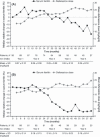Long-term safety and efficacy of deferasirox (Exjade) for up to 5 years in transfusional iron-overloaded patients with sickle cell disease
- PMID: 21592110
- PMCID: PMC3170481
- DOI: 10.1111/j.1365-2141.2011.08720.x
Long-term safety and efficacy of deferasirox (Exjade) for up to 5 years in transfusional iron-overloaded patients with sickle cell disease
Abstract
To date, there is a lack of long-term safety and efficacy data for iron chelation therapy in transfusion-dependent patients with sickle cell disease (SCD). To evaluate the long-term safety and efficacy of deferasirox (a once-daily oral iron chelator), patients with SCD completing a 1-year, Phase II, randomized, deferoxamine (DFO)-controlled study entered a 4-year extension, continuing to receive deferasirox, or switching from DFO to deferasirox. Average actual deferasirox dose was 19·4 ± 6·3 mg/kg per d. Of 185 patients who received at least one deferasirox dose, 33·5% completed the 5-year study. The most common reasons for discontinuation were withdrawal of consent (23·8%), lost to follow-up (9·2%) and adverse events (AEs) (7·6%). Investigator-assessed drug-related AEs were predominantly gastrointestinal [including nausea (14·6%), diarrhoea (10·8%)], mild-to-moderate and transient in nature. Creatinine clearance remained within the normal range throughout the study. Despite conservative initial dosing, serum ferritin levels in patients with ≥ 4 years deferasirox exposure significantly decreased by -591 μg/l (95% confidence intervals, -1411, -280 μg/l; P = 0·027; n = 67). Long-term deferasirox treatment for up to 5 years had a clinically acceptable safety profile, including maintenance of normal renal function, in patients with SCD. Iron burden was substantially reduced with appropriate dosing in patients treated for at least 4 years.
© 2011 Blackwell Publishing Ltd.
Figures




Comment in
-
Safety of deferasirox in sickle cell disease patients with co-existing liver impairment.Br J Haematol. 2012 May;157(4):505-6; author reply 506-7. doi: 10.1111/j.1365-2141.2012.09040.x. Epub 2012 Feb 2. Br J Haematol. 2012. PMID: 22299817 No abstract available.
Similar articles
-
Efficacy and safety of deferasirox compared with deferoxamine in sickle cell disease: two-year results including pharmacokinetics and concomitant hydroxyurea.Am J Hematol. 2013 Dec;88(12):1068-73. doi: 10.1002/ajh.23569. Epub 2013 Sep 19. Am J Hematol. 2013. PMID: 23946212 Clinical Trial.
-
A randomised comparison of deferasirox versus deferoxamine for the treatment of transfusional iron overload in sickle cell disease.Br J Haematol. 2007 Feb;136(3):501-8. doi: 10.1111/j.1365-2141.2006.06455.x. Br J Haematol. 2007. PMID: 17233848 Free PMC article. Clinical Trial.
-
Efficacy and safety of deferasirox at low and high iron burdens: results from the EPIC magnetic resonance imaging substudy.Ann Hematol. 2013 Jan;92(2):211-9. doi: 10.1007/s00277-012-1588-x. Epub 2012 Oct 21. Ann Hematol. 2013. PMID: 23086508 Free PMC article.
-
Long-term experience with deferasirox (ICL670), a once-daily oral iron chelator, in the treatment of transfusional iron overload.Expert Opin Pharmacother. 2008 Sep;9(13):2391-402. doi: 10.1517/14656566.9.13.2391. Expert Opin Pharmacother. 2008. PMID: 18710363 Review.
-
Long-term efficacy and safety of deferasirox.Blood Rev. 2008 Dec;22 Suppl 2:S35-41. doi: 10.1016/S0268-960X(08)70007-9. Blood Rev. 2008. PMID: 19059055 Review.
Cited by
-
Effect of deferasirox chelation on liver iron and total body iron concentration.Indian J Pediatr. 2013 Aug;80(8):655-8. doi: 10.1007/s12098-013-1030-y. Epub 2013 May 29. Indian J Pediatr. 2013. PMID: 23715791
-
The nephropathy of sickle cell trait and sickle cell disease.Nat Rev Nephrol. 2022 Jun;18(6):361-377. doi: 10.1038/s41581-022-00540-9. Epub 2022 Feb 21. Nat Rev Nephrol. 2022. PMID: 35190716 Free PMC article. Review.
-
Organizing national responses for rare blood disorders: the Italian experience with sickle cell disease in childhood.Orphanet J Rare Dis. 2013 Oct 20;8:169. doi: 10.1186/1750-1172-8-169. Orphanet J Rare Dis. 2013. PMID: 24139596 Free PMC article.
-
Pharmacogenetic study of deferasirox, an iron chelating agent.PLoS One. 2013 May 30;8(5):e64114. doi: 10.1371/journal.pone.0064114. Print 2013. PLoS One. 2013. PMID: 23737969 Free PMC article.
-
Transient Elastography (TE) is a Useful Tool for Assessing the Response of Liver Iron Chelation in Sickle Cell Disease Patients.Mediterr J Hematol Infect Dis. 2018 Sep 1;10(1):e2018049. doi: 10.4084/MJHID.2018.049. eCollection 2018. Mediterr J Hematol Infect Dis. 2018. PMID: 30210742 Free PMC article.
References
-
- Adams RJ, Brambilla D. Discontinuing prophylactic transfusions used to prevent stroke in sickle cell disease. New England Journal of Medicine. 2005;353:2769–2778. - PubMed
-
- Adams RJ, McKie VC, Hsu L, Files B, Vichinsky E, Pegelow C, Abboud M, Gallagher D, Kutlar A, Nichols FT, Bonds DR, Brambilla D. Prevention of a first stroke by transfusions in children with sickle cell anemia and abnormal results on transcranial Doppler ultrasonography. New England Journal of Medicine. 1998;339:5–11. - PubMed
-
- Ballas SK. Iron overload is a determinant of morbidity and mortality in adult patients with sickle cell disease. Seminars in Hematology. 2001;38(Suppl. 1):30–36. - PubMed
-
- Brittenham GM, Cohen AR, McLaren CE, Martin MB, Griffith PM, Nienhuis AW, Young NS, Allen CJ, Farrell DE, Harris JW. Hepatic iron stores and plasma ferritin concentration in patients with sickle cell anemia and thalassemia major. American Journal of Hematology. 1993;42:81–85. - PubMed
-
- Brown K, Subramony C, May W, Megason G, Liu H, Bishop P, Walker T, Nowicki MJ. Hepatic iron overload in children with sickle cell anemia on chronic transfusion therapy. Journal of Pediatric Hematology/oncology. 2009;31:309–312. - PubMed

